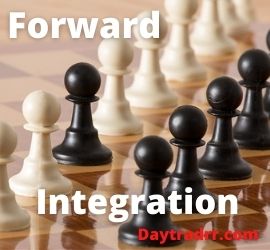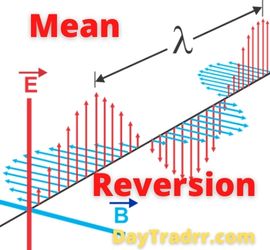What Is Forward Integration?
 Forward integration occurs when a company moves downstream in the value chain toward controlling the distribution of its products or services. It does this by acquiring or merging with businesses downstream that were its former customers. However, it still maintains control over its core business activities.
Forward integration occurs when a company moves downstream in the value chain toward controlling the distribution of its products or services. It does this by acquiring or merging with businesses downstream that were its former customers. However, it still maintains control over its core business activities.
Forward integration is a business strategy that involves a form of downstream vertical integration. The company maintains control of its core business activities that are ahead in the value chain. However, by integrating downstream through direct distribution, the company can consolidate costs and moves closer to the ultimate end customer.
This type of vertical integration is conducted by a company advancing along the supply chain. A good example of forward integration would be a farmer who directly sells his crops at a local farmer’s market rather than to a distribution center that controls the placement of foodstuffs to various supermarkets. A company implements forward integration strategies when it wants to exert wider control over the value chain of its industry. In return, it can optimize economies of scale, target better cost margins, and increasing its market share and profitability. In other words, it’s a business strategy where a firm replaces third-party distribution or supply channels with its own. As a result, it aims to consolidate operations, reduce costs, and become a step closer to the end consumer.
Forward Integration – A Closer Look
Forward integration, sometimes known as cutting out the middleman. It is an operational approach a firm can undertake when it wants to increase control over its retailers or distributors. However, a corporation must gain control of other companies that were once customers in order for forward integration to be successful. This strategy is the opposite of backward integration. Integrating backward is where a firm attempts to gain control of companies that were once its suppliers. With the emergence of the internet, forward integration has become both easier and more common as a company growth strategy.
For example, a manufacturer can set up an online store and sell its items using digital marketing. Previously, it had to rely on retail corporations and marketing firms to sell the products effectively. Forward integration allows a corporation to advance in the supply chain, increasing its overall ownership of the industry. The supply chain in standard industries consists of five steps. These are raw materials, intermediate goods, manufacturing, marketing and sales, and after-sales service. If a corporation wishes to integrate forward in the supply chain, it must acquire or merge with the next link along the chain. It does this while maintaining control over its existing operations and core expertise.
Benefits of Forward Integration
Generally, forward integration allows companies to sustain profits while minimizing profit losses to intermediate entities. The strategy can be implemented for different reasons, including:
- Increase the company’s market share – A company may increase its market share by implementing a forward integration strategy. Generally, the strategy eliminates various transaction and transportation costs. This subsequently results in a lower final price for the company’s product. Thus, a company can achieve greater market share through lower product prices.
- Gain control over distribution channels – A company employs the strategy if it wishes to obtain control over distribution channels in its industry. Control is crucial for companies that operate in industries that lack qualified distributors or in situations where distributors charge significant costs. The control over distribution channels ensures the strategic independence of a company from third parties.
- Competitive advantage – Successful implementation of the strategy may provide a company with a competitive advantage over its competitors. Lower costs and more control over industry distribution channels can become key factors in achieving a competitive advantage.
- Create barriers to potential competitors – The integration of entities forward of the company’s production vertically strengthens its position in the industry and establishes obstacles for potential rivals. For example, if a company integrates a large industry retailer, probable competitors could face limited access to distribution channels. (Source: corporatefinanceinstitute.com)
Risks
Companies should first be aware of the expenses and scope of forward integration. They should only pursue this strategy if there are cost savings. Equally important, the integration must not compromise its current core capabilities. Rather than expanding on its own, a company may find it more effective to rely on the established expertise and economies of scale of other providers. Another option is to integrate through acquisition or merger.
In situations where it is costing you money NOT to act, forward integration makes the most sense. For example, exorbitant shipping prices could compel you to consider the benefit of owning your own delivery truck. If your distributors and retailers benefit more than you do from your goods, it makes sense to at least consider taking over your own distribution and retail channels. However, look before you leap. You need to assess all the risks and advantages like you would with any other important business decision.
Examples of Forward Integration
In most cases, farmers sell their products to distributors who in turn deliver and sell it to retailers. Customers then buy the farm produce from the retailer. For the farmer to employ a forward integration strategy, he could cut out the distributor and sell to retailers directly. For example, he could do this by selling to local restaurants. Retailing his produce directly would move him one step ahead in the supply chain. Similarly, he might want to cut out both the distributor and the retailer. He could do this by selling directly to end customers through a Co-op with other farmers or retail his goods at a farmer’s market. This is an example of forward integration where the farmer can deal directly with the end customer.
Amazon
Since its inception, Amazon has been preoccupied with vertical integration, up and down the supply chain. The company’s goal was to produce goods that satisfy the needs of its clients and optimize them to the maximum. Initially, the strategy was to give them to third parties to profit from their development and operation. After achieving extremely high levels of operational efficiency in its warehouses, Amazon began offering companies the opportunity to keep their products there as well as employ the company’s picking and packaging services. Finally, Amazon began focusing on fresh goods delivery, building its own fleets of trucks and workers.
Offering its own logistics services is simply another logical step in Amazon’s vertical integration process. Once a company reaches a certain level of activity and has acquired sufficient operational experience, integrating can make sense. Providing this service to third parties is one way to try to boost volume in a business where scale is practically everything. Amazon will now try to innovate faster than its competitors in an area in which it has huge experience in issues such as drone deliveries, transoceanic and air logistics, and in-home deliveries. It also has registered patents for the robotization of distribution, beehive drone towers, and even aerial warehouses to reduce drone journey times. (Source: medium.com)
Up Next: What Is Functional Obsolescence?
 Functional obsolescence is when an asset becomes less useful because of an outdated design that cannot be readily renovated or modernized. It is the reduction of an object’s usefulness or desirability because of an outdated design feature that is difficult to change or update.
Functional obsolescence is when an asset becomes less useful because of an outdated design that cannot be readily renovated or modernized. It is the reduction of an object’s usefulness or desirability because of an outdated design feature that is difficult to change or update.
The application of the term varies based on industry. In real estate, it refers to the loss of property value due to obsolete features. For example, an older house with one bathroom in a neighborhood filled with new homes that have two bathrooms or more. It may also refer to outdated technologies. The iPhone made older versions of mobile phones obsolete. New and faster computer processors make older, slower versions obsolete.
- Obsolescence risk – Companies must constantly upgrade their processes, products, and technologies or face obsolescence risk. It occurs when a company falls behind competitors with functionally obsolete offerings. As a result, they can no longer be competitive in the marketplace.
- Planned obsolescence – is a strategy of deliberately ensuring that the current version of a given product will become out of date or useless within a known time period. In some cases, companies actively put policies in place to make products functionally obsolete. For instance, Apple Inc. has been criticized for not maintaining updates and customer service for older, outdated iPhones and other devices. By refusing support or updates for older models, Apple is accelerating the functional obsolescence of its older product offerings.




